It’s all about having the right tool for the job. Whether you’re a professional auto mechanic or just learning some basic car maintenance, having the right equipment can make any task go far more easily. Here’s a round-up of our favorite tools to save time and energy when working on vehicle repairs.
1. Under-hood work light
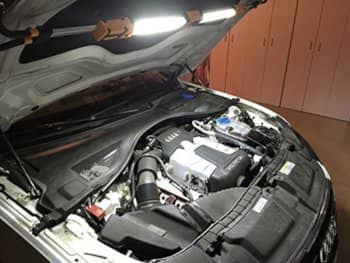
You can’t do anything if you can’t see what you’re doing, and an underhood work light provides illumination exactly where you need it. There’s no way you can block your own light by standing in the wrong place.
If you’ve ever had to pop your hood open on a dark road, holding a flashlight between your teeth while you try to find the source of that clunking noise coming from your engine, you’ll understand why this light is so useful. It also works great to light up the underside of the body – just pop it off its holder.
2. Mobile gear seat
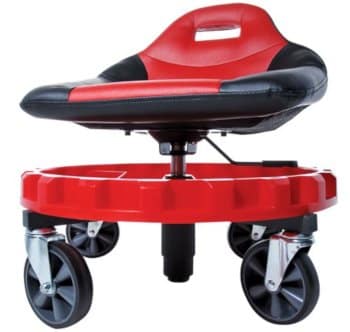
Auto mechanics have one of the highest rates of injury of any civilian job, and it’s partly because of all the time spent stretching over engines and squeezing into awkward positions under a raised chassis.
An adjustable gear seat lets you sit at a comfortable height while working under a vehicle instead of crouching on a cold floor, preventing you from developing that crunching feeling in your lower back after a few hours’ work.
Check out the top 10 best reviewed shop seats and creepers available here:
10 Best Garage Shop Seats: Mechanic’s Rollers, Creepers & Workbench Stools
3. Topside creeper
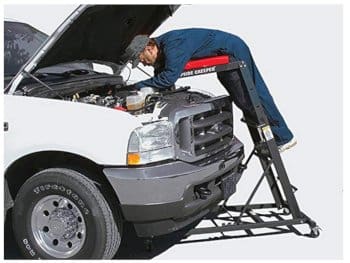
Another tool to save an auto mechanic’s back, a topside creeper is an angled ladder which allows you to access the engine from above. It’s great for working on vehicles which sit high off the ground, like SUVs or trucks, but you can also adjust the height so you can use it on smaller vehicles too.
4. Garage creeper
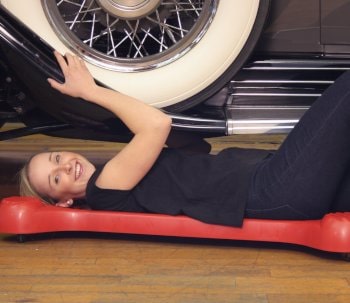
A creeper is a basic bit of kit for anyone who’s serious about home car repairs. It allows you to get underneath a jacked-up car without having to raise it all the way up using a hoist. This particular model is unpadded and has a rise of just 3 inches, making it easier for big and tall mechanics to fit.
5. Tire step
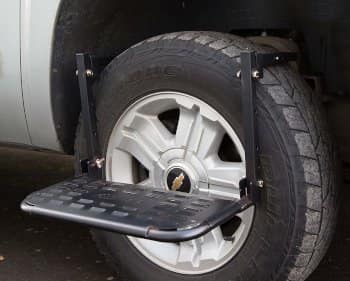
Designed for SUVs and trucks, this tire step is a tool for when you need closer access to your vehicle but the job isn’t quite big enough to need a topside creeper. It’s great for little five-minute jobs like checking the oil, changing the wiper blades, or even de-icing the windshield
Special tools for tight spots
6. Automotive pry tools
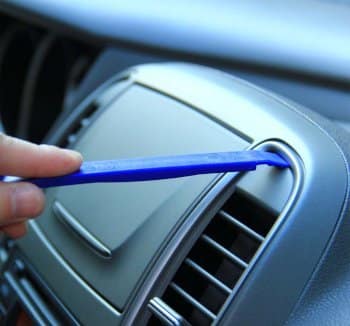
This set of prying tools are designed for lifting pieces of interior trim – think prising out door panels, levering up moldings, or removing old upholstery. The tools come in a variety of shapes to reach different sized nooks, and have pin pullers set into the ends to yank out small fasteners like those which hold molding grips. Best of all, the tools are made of non-scratch plastic, so there’s no worry about chipping your paint job or scratching the panels.
7. Crowfoot wrench set
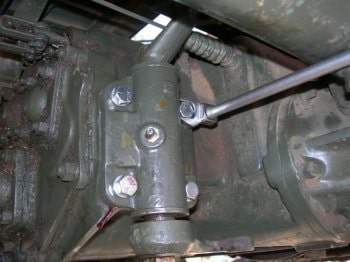
A crowfoot wrench is perfect for working in a tight spot like around a radiator. You attach the wrench head to any standard ⅜” drive extender and then you can adjust your nuts and bolts from arms’ length. The flared design is great for working with power steering or brake lines: just slip the line through the opening and then twist it loose.
8. Precision hook set
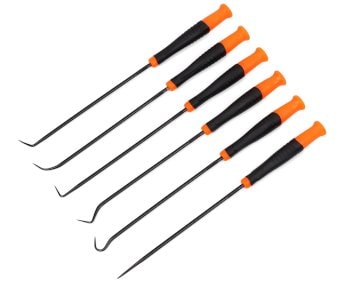
From picking up O-rings off your oil filter to separating fine wires, there are all sorts of jobs that need more precision than you can manage with your bare fingers. A set of precision hooks allows you to get into tight spaces, and the varied head shapes work for all sorts of different tasks – use the straight pick for dislodging crud which is too baked-on for a Q-tip, or the curved hook for picking up dropped washers from inconvenient places.
9. Ratchet extender
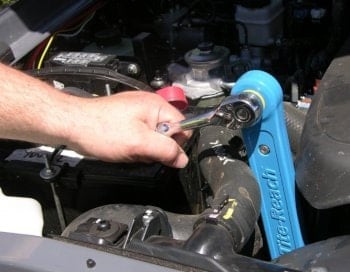
Engine compartments are getting more crowded than ever, meaning there’s a lot less space for your tools. This reach extender allows you to ratchet a bolt using a regular socket wrench, without having to fit the whole wrench into the space. Just put your socket on one and and attach your ratchet to the other, and you can easily loosen or tighten that hard-to-reach bolt.
10. Flexible sockets
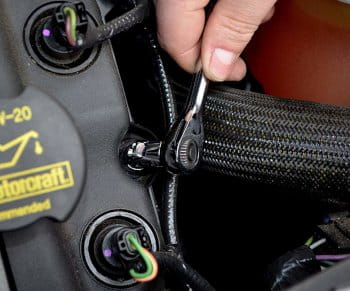
Flex sockets have a much shorter profile than a regular combination of socket and universal joint, allowing you to loosen and tighten bolts in tight spots. They’re great for under-dash work, where you need precise leverage but won’t be applying huge amounts of torque.
11. Locking extension bar set
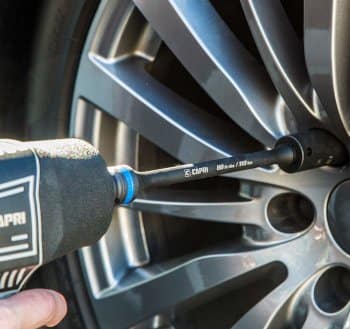
Getting the wrong torque when tightening a fastener can do serious damage to your vehicle. Too much torque when tightening the lug nuts can damage your brake rotors or stretch your wheel studs, and if you don’t apply enough torque then the whole wheel can come loose. Combined with an impact wrench, these extension bars have a torque limit to make sure you apply exactly the right torque as advised by your car manufacturer.
12. Short and long-nose kiwi pliers
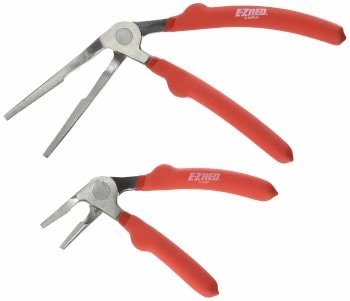
With an angled head, these narrow pliers are perfect for awkward spots like hose clamps where regular pliers can’t get a proper grip. The serrated teeth and pistol grip mean you can get a good firm hold from any angle.
13. Telescoping mirror and magnet set
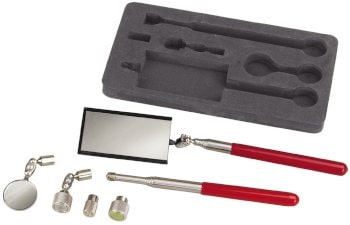
Save time and energy by checking out what’s happening under the body before you get out your creeper. This set has extendable mirrors in two sizes, a large one to look under the car or check out the engine, and a small one for delicate jobs like fixing dashboard wiring.
14. Quality socket-wrench set
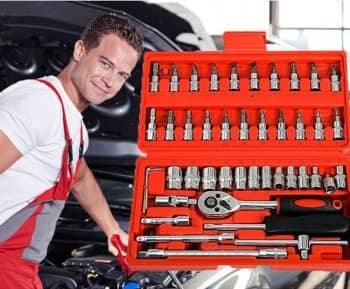
This 168-piece set contains dozens of different items – sockets, ratchets, angled adapters, screwdriver bits, hex keys – all made by the well-respected DeWalt brand. At 25lb, the carry case is a serious piece of kit, and it’s a great upgrade for your drawer full of mismatched tools. The sockets are both metric and SAE measurements, so they’re suitable for either foreign or domestic cars.
15. Digital torque adapter
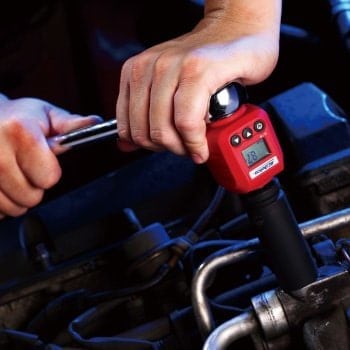
This adapter turns any ratchet wrench into a digital torque wrench, so you can tighten your nuts to just the right pressure without having to buy several different sizes of torque wrench. As well as a digital display, it gives an increasing frequency of beeps as you approach your pre-set torque level, which then becomes a constant tone when you’re at just the right level.
16. Nut splitter
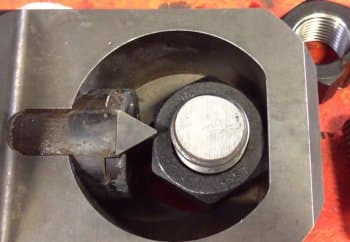
If you work on old vehicles, you know the trouble which rusted-on nuts can cause. A single stuck nut can disrupt a whole repair job, and heat, torque, and WD-40 will only work so far. This simple gadget works a bit like a Christmas nutcracker.
Put the opening around the head of the nut and slowly tighten the screw. With a bit of luck, the splitter will dig into the nut and allow you some extra leverage to work it loose; if not, a few more twists will break the nut into pieces, allowing you to free the bolt without damaging the thread.
Electric & electronics , Diagnostics
17. Circuit tester
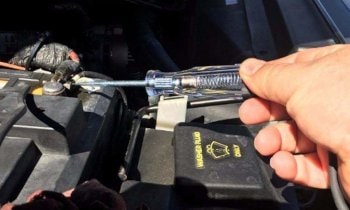
If there’s something draining the battery in your car, it’s probably an electrical fault. This circuit tester allows you to find and isolate blown fuses or loose wires. Just attach the end clip to a grounding circuit (any bolt that goes through the frame of the car should work fine) and use the probe to test the current. The probe is sharpened, so you can poke through corrosion or insulation.
18. Automotive stethoscope
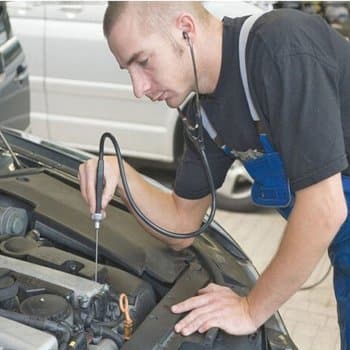
Often, the first sign of a problem with a car is a weird noise. If your vehicle is clunking, or whistling, or rattling, you can bet it signals a small problem which is about to turn into a big expensive issue.
An automotive stethoscope helps you to identify the source of the issue. This device has two interchangeable heads for different types of sound – a diaphragm chamber to pick up on mechanical noises, and a funnel amplifier which picks up on air noises like vacuum leaks.
19. Vacuum pump and brake bleeder
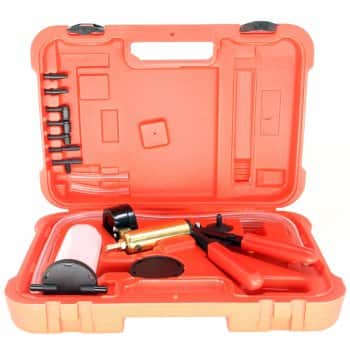
Flushing and replacing the brake fluid on your car is easy, but it’s fiddly to do it manually. This vacuum means you can easily suck old brake fluid out of the bleeder screws – just attach and keep pumping until you see fresh fluid coming through the tubing. You can also use this test tuner tool kit to flush power-steering fluids, or use the gauge to find a leaking vacuum line – just plug each line in turn and see whether the gauge flutters, indicating that the pump is sucking in air from a hairline crack.
20. Spark plug boot pliers
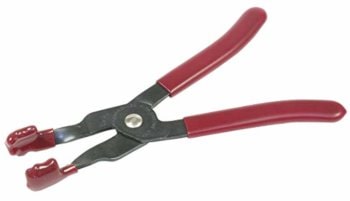 Spark plug wires are expensive, and just one broken wire means you need to replace the whole set. But the wires attach way back in the engine, and have often accumulated a layer of gunk which makes it a real challenge to work them loose using your fingers. These specially-shaped pliers allow you to get a firm grip without a risk of damaging the internal electrical connections.
Spark plug wires are expensive, and just one broken wire means you need to replace the whole set. But the wires attach way back in the engine, and have often accumulated a layer of gunk which makes it a real challenge to work them loose using your fingers. These specially-shaped pliers allow you to get a firm grip without a risk of damaging the internal electrical connections.
21. Shop battery charger and jumper
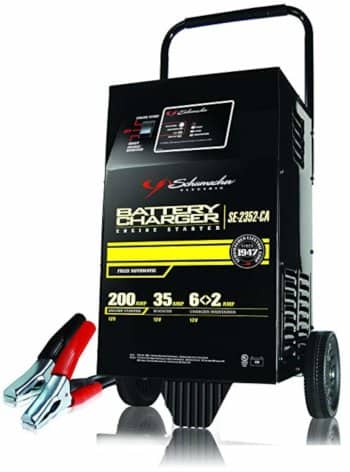
This high-powered batter charger is designed for industrial use, to rapidly recharge batteries which have run out of juice. As well as its three levels of current (for slow, medium, or fast charging) it can also be used for emergency starts, or testing battery load.
22. Battery carrier
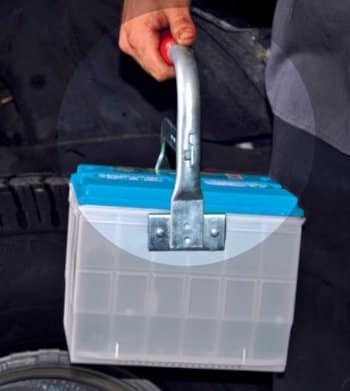
Auto batteries are heavy, awkwardly shaped, and full of dangerous acid: not a comfortable thing to carry in your hands. In addition, they’re designed to wedge tightly into their compartment, meaning they’re hard to lever out and it’s easy to catch a finger when dropping them into place.
It won’t make batteries any lighter, but this snap-on battery handle makes them much easier to maneuver. Just clip it to the top of the battery and you can lift them easily with one hand.
23. Hose removal tool
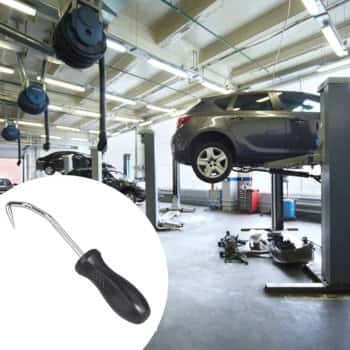
Whether it’s a transmission line or a radiator hose, a tight seal between a hose and fitting is essential. That is, until you want to remove the freaking thing. This hose removal tool has an inverted hook, designed to break the seal and pull the hose free without damaging it.
24. Diagnostic car scan tool
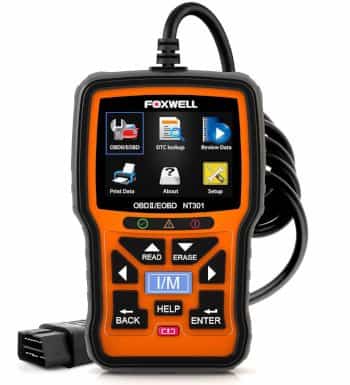
The ‘check engine light’ is more trouble than it’s worth. It tells you something is wrong… but what? This diagnostic scanner is designed to check hard-to-see systems like emission levels. It instantly identifies manufacturer error codes and tells you the source of the problem, so you can get it fixed.
Heavy duty tools
25. Air compressor
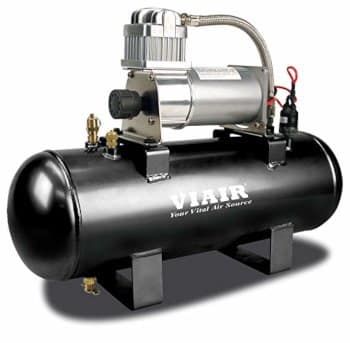 An air compressor is a tool which you probably never realized you needed but will end up wondering how you lived without. It’s designed to use with an air horn, but you can also use it to top off your tire pressure or use with a diesel exhaust brake. It’s quiet enough to keep in the cab of your truck but it’s powerful enough to fill up the air horn tank fast.
An air compressor is a tool which you probably never realized you needed but will end up wondering how you lived without. It’s designed to use with an air horn, but you can also use it to top off your tire pressure or use with a diesel exhaust brake. It’s quiet enough to keep in the cab of your truck but it’s powerful enough to fill up the air horn tank fast.
26. Engine hoist
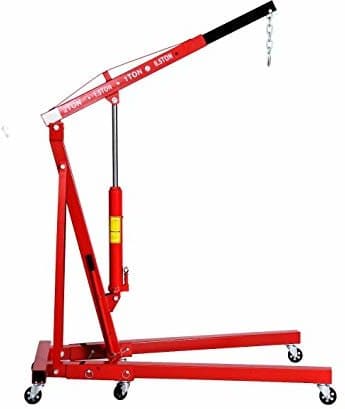
An engine hoist allows you to lift up and remove the entire engine from a vehicle, so you can move it to a workbench and get easy access to all the components. This model has swiveling wheels for maneuverability, so you can also use it to move heavy items like axles and transmissions around the shop.
27. Cross beam floor jack
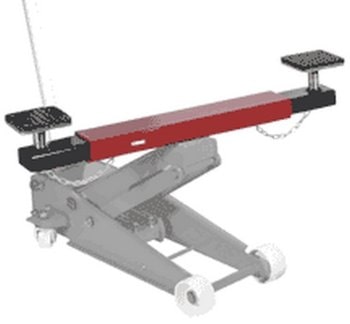 Newer cars usually need to be lifted in two places for maintenance: instead of getting out two jacks, just fit this cross-beam extender to a single jack. Then simply adjust to the right width for your vehicle and pump until the chassis is is up in the air.
Newer cars usually need to be lifted in two places for maintenance: instead of getting out two jacks, just fit this cross-beam extender to a single jack. Then simply adjust to the right width for your vehicle and pump until the chassis is is up in the air.
28. Transmission jack
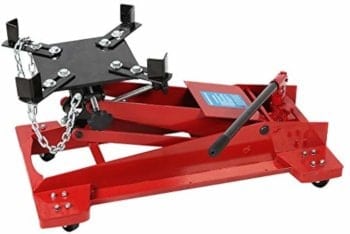
A jack like this is designed for either removing or installing a transmission. Use the hydraulic height adjustment to wrestle the transmission into the correct position underneath your vehicle, then use the tilt function to adjust the level until your bolt holes are aligned. As long as you’re prepared to fill and bleed the internal cylinder, it’s far easier than fighting with a floor jack when fixing a clutch.
29. Hydraulic shop press
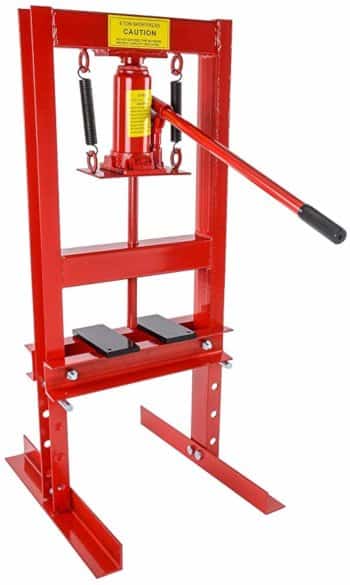
A small hydraulic press is useful for all sorts of jobs in your shop. It’s great for removing and installing press-fit parts like gears or bearings. If something’s bent and should be straight, a press will sort it out, and the same if it’s straight but you want it bent. Combined with an inexpensive extra gauge, a press can also be used to test valve or suspension sprints.
30. Strut spring compressor
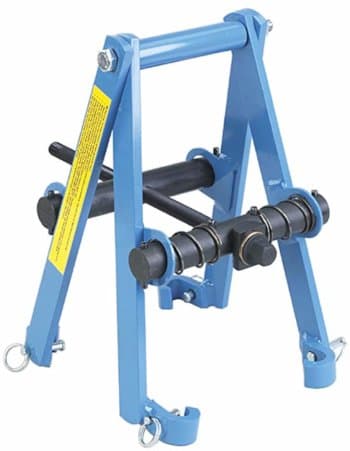
Changing strut springs with a manual spring compressor is a headache, and you’ll often see compressor bending at some alarming angles. This clamshell spring compressor has locking jaws to hold it in place for safety: a few turns with an impact wrench are all you need to compress the spring enough to loosen the top nut.
31. Brake lathe
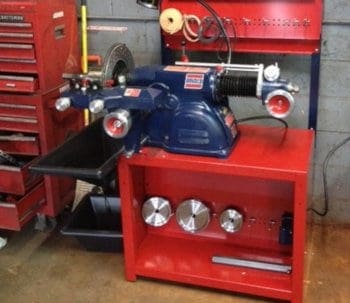
A brake lathe shaves off a fraction of a millimeter from the surface of a brake disc, smoothing out the rough surfaces which can cause shaking and juddering. Ever been advised to go easy on a new set of brake pads for the first hundred miles? This dangerous ‘bedding in’ period is due to unevenness between the surface of the pad and the disc, which can be skimmed off using a brake lathe.
32. Vehicle lift
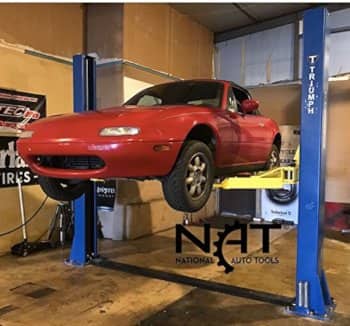 For easy access to a vehicle’s underside, you can’t beat the convenience of a two-post lift – drive in, lift it, fix it, drive out. This one is great for a motor shop but would also work for a large home garage, since it sinks into the floor with a concrete footbed rather than needing you to dig down to make space for an in-ground lift.
For easy access to a vehicle’s underside, you can’t beat the convenience of a two-post lift – drive in, lift it, fix it, drive out. This one is great for a motor shop but would also work for a large home garage, since it sinks into the floor with a concrete footbed rather than needing you to dig down to make space for an in-ground lift.
Pneumatic tools
33. Air hammer with Needle scaler attachment
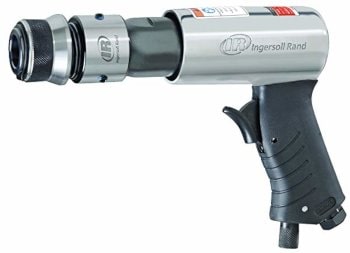 An air hammer is a handy piece of equipment to have, since you can use it as a chisel, a punch, or a panel cutter. A needle scaler attachment adds yet another use: these fine-packed sharp needles scrape off rust and old paint, great for repairs on old vehicles. The collar allows you to adjust the needle force and the area of coverage, for more or less intensity.
An air hammer is a handy piece of equipment to have, since you can use it as a chisel, a punch, or a panel cutter. A needle scaler attachment adds yet another use: these fine-packed sharp needles scrape off rust and old paint, great for repairs on old vehicles. The collar allows you to adjust the needle force and the area of coverage, for more or less intensity.
34. Air ratchet
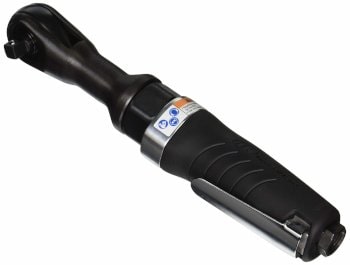
An impact wrench will have a better prospect of cracking the nut loose by virtue of its higher torque. Air ratchets are designed to loosen or tighten bolts which need fairly low torque. They’re designed to save work, while fitting the bolts neatly without risk of over-torquing: they are also much easier to use in tight spaces, since you don’t need any space to crank the wrench as you would if you were loosening nuts by hand.
35. Impact wrench / High torque pneumatic wrench
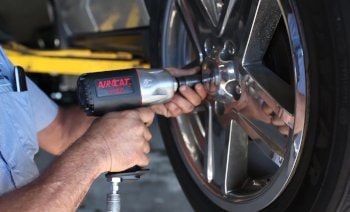
An air ratchet is designed to save you the effort of adjusting nuts by hand; an impact wrench is made for nuts which need more torque than one arm can provide. Whether it’s a rusted-in bolt that just won’t loosen, or a camshaft sprocket which needs to be fitted with super-high torque for safety, an impact wrench will provide 900 ft-lb or more of torque power.
36. Battery powered lug nut wrench
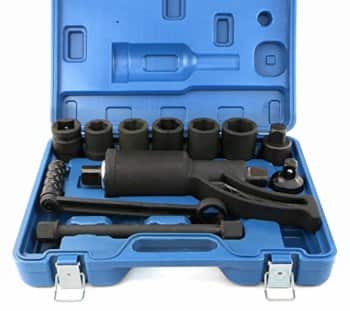
Tired of jumping up and down on a cheater bar trying to loosen your lug nuts? This wrench is designed to multiply the force you exert, making it much easier to remove stuck lug nuts from wheels which haven’t been changed in years. It’s battery powered so doesn’t need an air compressor, making it ideal for home repairs.
Cleaning
37. Oil drain, oil caddy
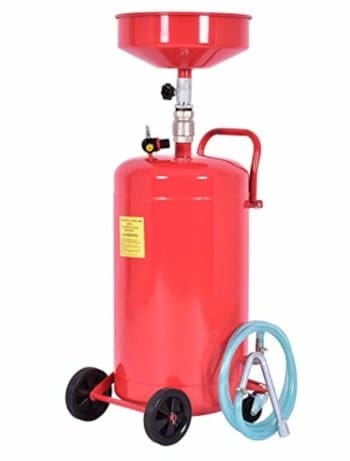
Changing the oil in a car isn’t a difficult job, but it’s nobody’s favorite task. Draining the oil by hand into a drip pan is slow and messy. This air-powered oil drain tank will slurp out the old oil through a hose, and then you can roll it by its wheels over to a waste container. Though it’s designed for oil, this caddy also works for evacuating things like brake and transmission fluid.
38. Fluid evacuator
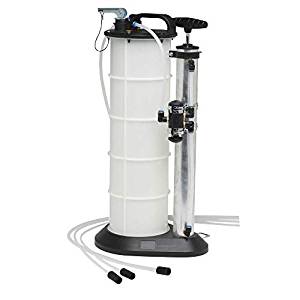 Draining oil from a car means you need to raise the vehicle in the air, undo the oil cap, and let gravity do its work – unless you’re lucky enough to have an auto lift in your home workshop, you’ll probably have to ask for professional help.
Draining oil from a car means you need to raise the vehicle in the air, undo the oil cap, and let gravity do its work – unless you’re lucky enough to have an auto lift in your home workshop, you’ll probably have to ask for professional help.
By using a pump to extract the fluid instead, you can clear out the oil while the vehicle stays flat on the ground, all without having to remove the drain plug or replace the drain bolt washer. This extractor has a manual pump instead of being air powered, meaning it’s great for home repairs.
Automotive organizers
39. Magnetic wrist belt
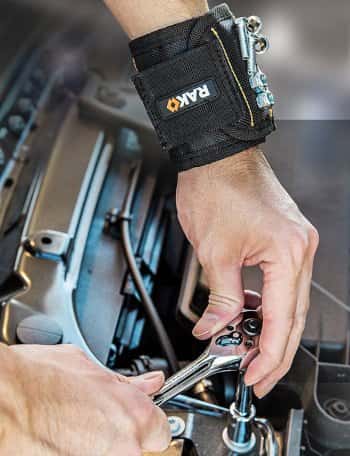 When working on a car, you want to have your bolts, nuts, and drill-bits to hand – but it’s a pain in the butt if you accidentally knock a little metal widget into the engine compartment and then have to spend half an hour fishing it out with pliers. This magnetic wrist belt allows you to keep all your small items conveniently to hand, without the risk of dropping or losing things.
When working on a car, you want to have your bolts, nuts, and drill-bits to hand – but it’s a pain in the butt if you accidentally knock a little metal widget into the engine compartment and then have to spend half an hour fishing it out with pliers. This magnetic wrist belt allows you to keep all your small items conveniently to hand, without the risk of dropping or losing things.
40. Magnetic socket organizer
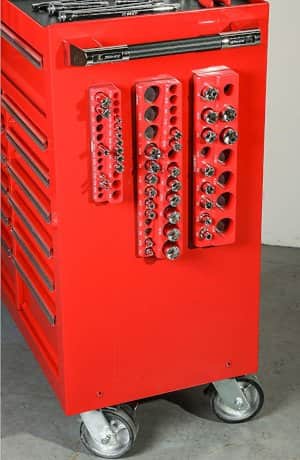
This holder is designed to organize all your sockets into easy-to-reach order of size, and it uses magnets to hold them in place when you chuck the organizer into your toolkit. Best of all, the magnets work in any direction, so you can mount it vertically on any metal surface or even stick it upside down in a metal cupboard.
41. Chrome socket labels
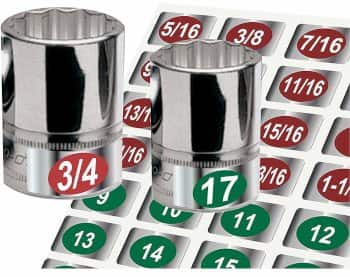
There’s nothing more frustrating than rummaging through a toolbox, looking for a specific size of socket which you know is in there…somewhere. These brightly-colored labels allow you to tell the socket size at a glance, and they even come in different shades to differentiate between metric and SAE sizes.
42. Carbide scriber
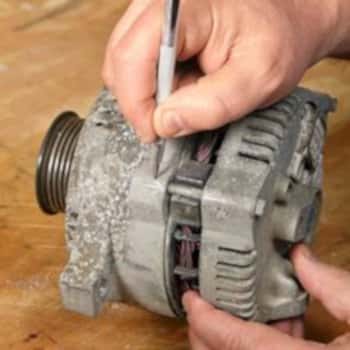
The secret to easier car repairs is to mark each part before disassembly. Put numbers or alignment marks on each part before you remove it, and it’s a piece of cake to put it all back together afterwards. A carbide scriber has a sharp tip to scratch into almost any surface, and gives a much finer stroke than a Sharpie or pencil.
Last Updated on May 7, 2019 by Tyler
